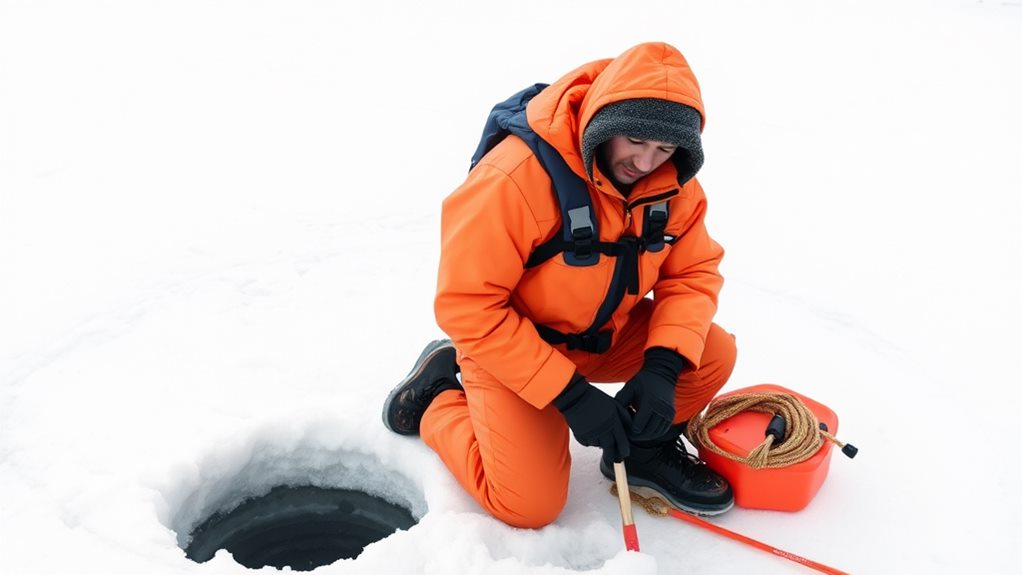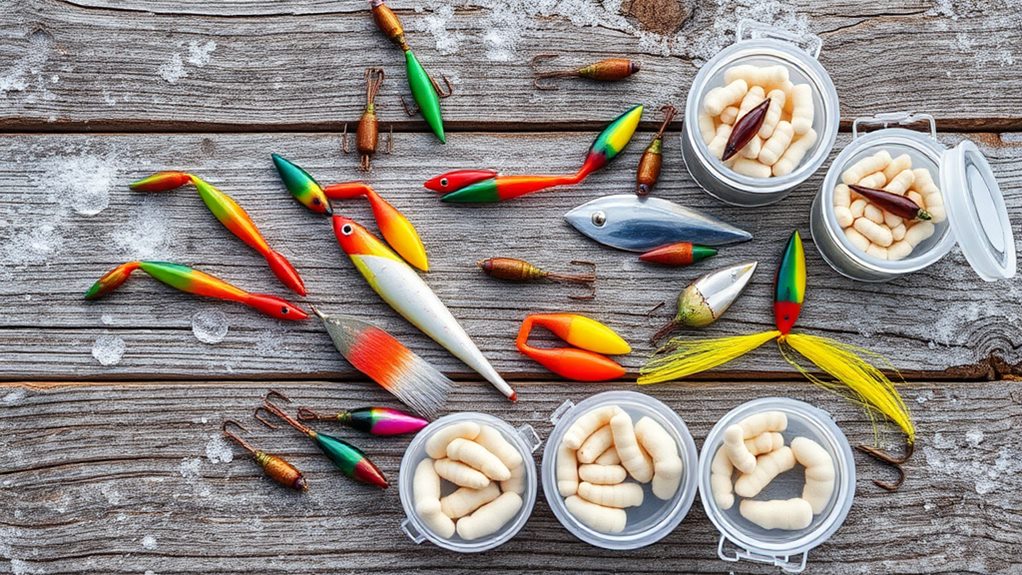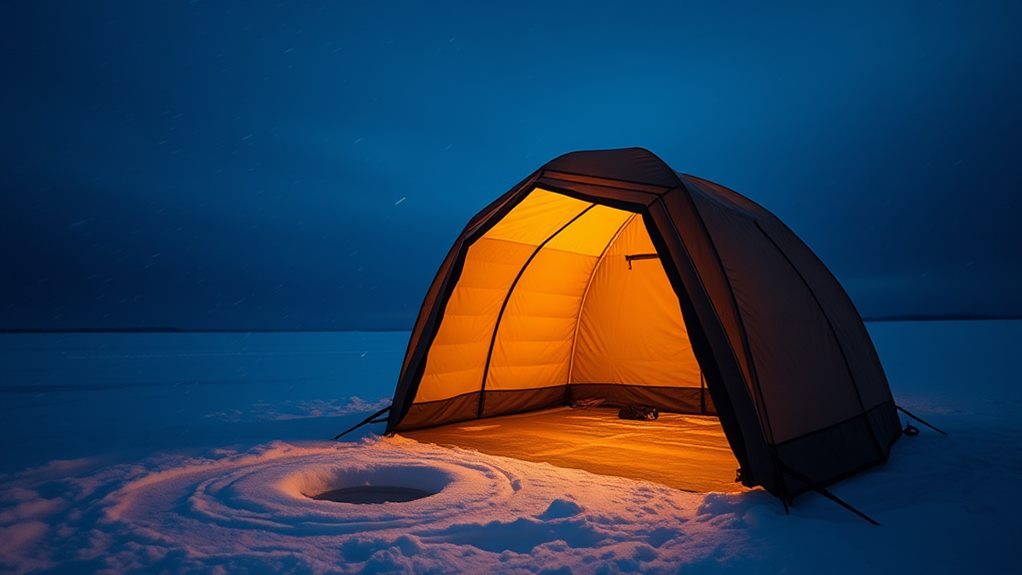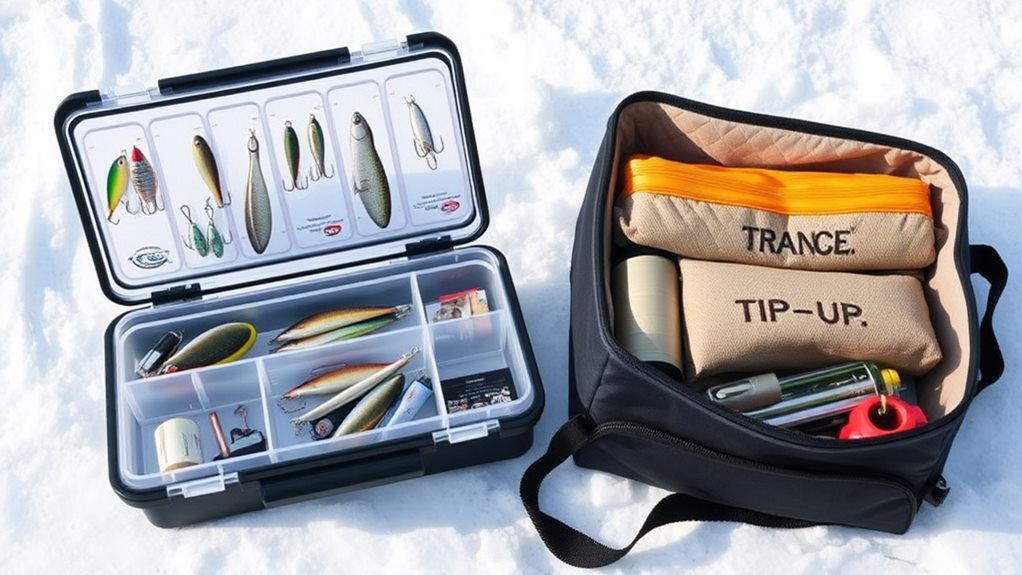Crucial ice fishing gear isn't just about catching fish – it's about staying safe and comfortable on frozen lakes. You'll need key safety items like ice picks and a life jacket for emergencies, proper cold-weather clothing layers to prevent hypothermia, and basic tools including an ice auger and fishing rod combo to actually catch fish. A portable shelter and heater will keep you protected from harsh winter conditions, while fish-finding technology helps locate your targets efficiently. Whether you're a complete beginner or advancing your skills, understanding and having the right gear creates a foundation for successful, safe ice fishing adventures.
Safety Equipment Saves Lives

First, you'll want to keep ice picks easily accessible. These simple tools could save your life if you fall through, as they'll help you grip the ice and pull yourself to safety.
Don't forget your life jacket or float suit, which provides essential buoyancy if you end up in frigid water. While some might think they're bulky, the extra warmth and flotation are worth the minor inconvenience.
A well-stocked first aid kit is another must-have for addressing unexpected cuts, scrapes, or more serious injuries while you're out on the ice.
You'll also need ice cleats to maintain steady footing – they're like winter tires for your boots!
Choose Proper Cold Weather Clothing
Staying warm and dry on the ice requires three vital clothing layers that work together to protect you from harsh winter conditions.
Your cold weather clothing strategy starts with a base layer made of moisture-wicking materials like polyester or merino wool, which keeps sweat away from your skin while maintaining body heat. This foundation is fundamental for preventing hypothermia during long hours on the ice.
For your middle layer, you'll want to focus on insulation. Fleece-lined pants and insulated vests create a thermal barrier that traps warmth close to your body.
Don't skimp on this layer – it's your primary defense against freezing temperatures.
Your outer layer should be a dedicated ice fishing suit that offers both wind protection and flotation capabilities. This specialized gear provides critical protection from the elements while ensuring your safety if you accidentally break through the ice.
Don't forget these vital accessories:
- Insulated, waterproof boots
- Balaclava or neck warmer
- Flip mitts for easy line handling
- Thermal socks
Basic Tools For Starting Out

Successfully catching fish through the ice requires a core set of fundamental tools that every beginner should acquire. Your most crucial gear starts with an ice auger, which you'll need to create holes in the frozen surface – consider a hand auger for thinner ice or a powered version if you're dealing with thick ice conditions.
While you're setting up, don't forget to wear ice cleats to maintain secure footing on slippery surfaces. Additionally, having at least one reliable top ice fishing tip-up in your gear will allow you to monitor multiple holes and increase your chances of a catch.
A quality ice fishing rod and reel combo, typically available for around $30-$40, will serve as your primary fish-catching tool. You'll want to pair this with a well-organized tackle box containing various jigs, lures, and live bait options like wax worms and minnows.
These versatile combinations will help you adapt to different fishing scenarios and target species. To maximize your fishing efficiency, invest in a few tip-ups. These clever devices allow you to monitor multiple holes simultaneously while keeping your hands free for other tasks.
With these basic tools in your arsenal, you'll be well-equipped to start your ice fishing journey and increase your chances of landing that memorable catch.
Selecting The Right Rod Setup
Choosing the right rod setup can make or break your ice fishing experience. When you're just starting out, you'll want to focus on crucial gear that combines functionality with value. A shorter rod, typically between 24 and 36 inches, will give you better control and sensitivity when fishing through ice holes.
For beginners, a spinning reel paired with an ice fishing rod is your best bet. It's easier to handle and helps prevent line tangles, which can be especially frustrating in cold conditions. You don't need to break the bank either – a quality rod and reel combo around $30-$40 will serve you well as you learn the basics.
Your fishing line choice matters just as much as your rod selection. Opt for ice fishing-specific line in the 2-4 pound test range, as it's designed to perform in frigid temperatures without becoming brittle.
For different species, you'll want to match your rod's action accordingly:
- Ultralight action for panfish
- Light action for medium-sized fish
- Medium action for larger catches
Essential Baits and Lures

A beginner's tackle box should include both live bait and artificial lures to maximize fishing success through the ice. Live bait options like minnows, wax worms, and maggots are proven favorites that'll consistently attract fish, especially when they're feeling sluggish in cold water.
You'll want to keep these fresh and lively to guarantee they catch attention beneath the ice.
When it comes to ice fishing lures, you can't go wrong with jigs and spoons. These artificial options mimic injured baitfish and trigger predatory instincts in species like walleye and pike.
For early morning or late evening fishing, consider adding glow-in-the-dark lures to your arsenal – they're particularly effective when visibility is low.
Don't overlook the versatility of soft plastics and scented baits. Soft plastic grubs and worms can be worked in various ways to entice strikes, while scented baits provide that extra attractant that often makes the difference in cold conditions.
Transportation Across Frozen Lakes
Getting your gear across a frozen lake safely and efficiently requires the right transportation equipment. An ice fishing sled is an vital tool that you'll need to master for successful winter angling.
You'll want to choose a sled that's lightweight yet sturdy enough to handle heavy loads, typically between 65 to 100 pounds of equipment. When you're trekking across frozen waters, having the right transport gear can make the difference between an enjoyable outing and an exhausting ordeal.
Before heading out with your loaded sled, remember these significant considerations:
- Always verify ice thickness at multiple points along your route, ensuring it's safe for both you and your equipment.
- Select a sled with high sides to prevent gear from tumbling out during transport.
- Consider a toboggan-style design if you'll be covering longer distances, as they glide more smoothly.
- Don't overload your sled beyond its recommended capacity, even if the ice seems thick.
When choosing your sled, focus on finding one that balances capacity with maneuverability.
You'll appreciate having a reliable transportation solution that keeps your gear organized and secure while traversing across frozen lakes.
Shelter Options For Harsh Weather

Reliable shelter stands as your first line of defense against brutal winter conditions while ice fishing. When you're facing frigid temperatures and biting winds, you'll need proper protection to stay comfortable and safe on the ice.
Portable fish houses, particularly flip-over shelters, offer excellent wind protection and heat retention, letting you focus on fishing rather than fighting the elements.
For group outings, you'll find hub shelters particularly useful. They're quick to set up and provide plenty of room for multiple anglers, while standing strong against harsh winter conditions.
Don't forget to pair your shelter with vital safety features – a battery-powered carbon monoxide detector is a must when using portable heaters inside your shelter.
Your personal protection matters just as much as your shelter choice. You'll want to invest in an insulated ice fishing suit, which not only keeps you warm but often includes built-in flotation features.
When you're setting up your ice shelter, consider adding a portable propane heater with low oxygen sensors for additional warmth.
Fish Finding Technology Matters
Once you've got your shelter sorted, understanding what's happening beneath the ice becomes your next vital advantage.
Modern fish finding technology has revolutionized ice fishing, making it easier than ever to locate and catch fish through the frozen surface. With affordable options now available, you'll find that investing in basic sonar technology can remarkably improve your success rate.
Your fundamental fish finding gear should include depth sounders or color flashers, which provide real-time information about what's happening below. These devices not only show you where the fish are but also display critical water temperature readings and underwater structures that attract fish.
Here's what fish finding technology can do for your ice fishing experience:
- Eliminate guesswork by showing exact fish locations and depth
- Help you understand fish behavior through real-time movement tracking
- Save time by reducing the number of holes you'll need to drill
- Display important data about water conditions and structure
Consider starting with a basic unit that includes key features, then upgrade as your skills develop.
Storage Solutions For Equipment

Proper storage solutions serve as the backbone of successful ice fishing expeditions, protecting your valuable gear while keeping it organized and readily accessible. When you're out on the ice, you'll need efficient ways to transport and protect your equipment from harsh winter conditions, especially considering the specific equipment needed for ice fishing.
Start with compact tackle boxes from trusted brands like Flambeau or Plano to keep your jigs, lures, and other small items neatly organized.
You'll want to invest in quality rod cases, particularly hard-plastic options, which will protect your ice fishing rods from damage during transport and storage. They're worth every penny when you consider the cost of replacing broken equipment.
A 5-gallon bucket is your multi-purpose friend on the ice – it stores gear and doubles as a convenient seat while you're waiting for that big catch.
To tie everything together, ice fishing sleds are vital for hauling your equipment across frozen lakes. They'll save your back and guarantee you can bring along everything you need without making multiple trips.
Emergency Preparedness On Ice
Safety on the ice demands more than just fishing gear – it requires a detailed approach to emergency preparedness. When you're out on frozen waters, having the right safety equipment can make the difference between a close call and a catastrophe.
Your crucial emergency kit should include ice picks, a life jacket or float suit, and an all-encompassing first aid kit that'll keep you prepared for unexpected situations.
To guarantee you're fully equipped for ice fishing emergencies, follow these critical safety measures:
- Always wear ice cleats to maintain stable footing and prevent dangerous slips that could lead to injury.
- Keep ice picks within easy reach, preferably attached to your outer clothing for quick access if you break through.
- Don't forget to wear your life jacket over your winter clothing – it's your primary defense against drowning.
- Store a whistle in an accessible pocket to signal for help when needed.
Frequently Asked Questions
What Does Every Ice Fisherman Need?
You'll need an ice auger, fishing rod and reel combo, tip-ups, and a well-stocked tackle box. Don't forget warm clothing and insulated boots to stay comfortable while you're fishing on ice.
What Essentials Do You Need for Fishing?
You'll need a fishing rod, reel, line, hooks, sinkers, and a tackle box with various lures. Don't forget bait, fishing license, and basic tools like pliers. Comfortable clothing's crucial for outdoor success.
What Equipment Is Used for Ice Fishing?
You'll need an ice auger to drill holes, ice fishing rod and reel combo, tip-ups, tackle box with jigs and spoons, plus insulated clothing and boots to stay warm during your ice fishing adventure.
What Should I Get for Ice Fishing?
You'll need an ice auger to drill holes, a rod and reel combo, tip-ups for multiple fishing spots, basic tackle like jigs and lures, and warm clothing including insulated boots and layers.
Final Thoughts
You'll find that proper gear makes all the difference between a successful, safe ice fishing trip and a miserable or dangerous one. By investing in crucial safety equipment, appropriate clothing, and basic tools, you're setting yourself up for an enjoyable experience on the ice. Remember, it's better to start with quality fundamentals than to learn the hard way why they matter. Take your time selecting gear, and you'll be catching fish through the ice in no time.




